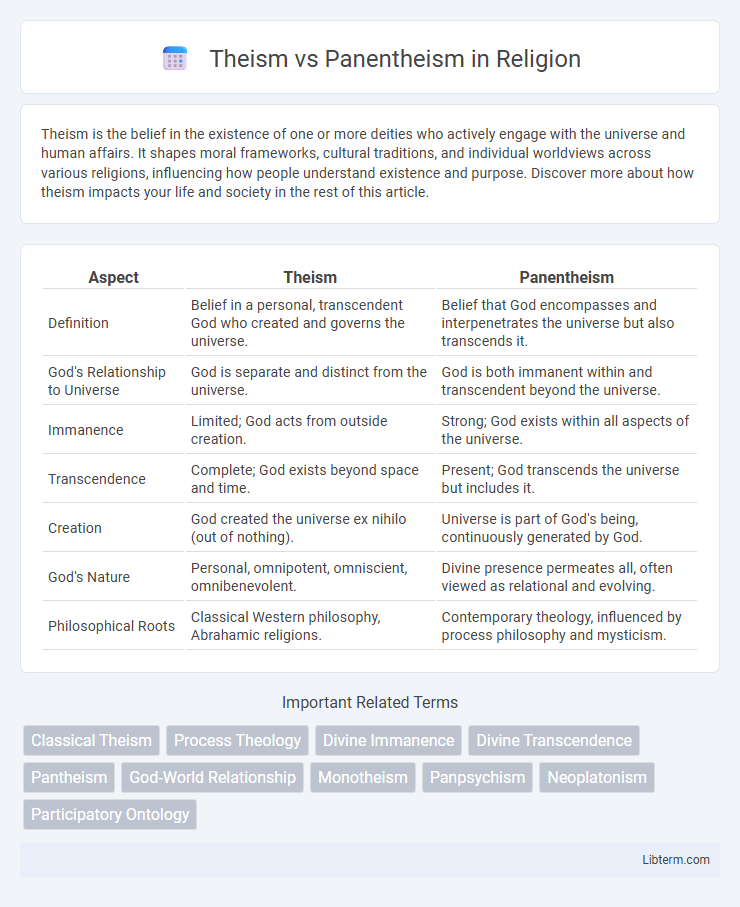Theism is the belief in the existence of one or more deities who actively engage with the universe and human affairs. It shapes moral frameworks, cultural traditions, and individual worldviews across various religions, influencing how people understand existence and purpose. Discover more about how theism impacts your life and society in the rest of this article.
Table of Comparison
| Aspect | Theism | Panentheism |
|---|---|---|
| Definition | Belief in a personal, transcendent God who created and governs the universe. | Belief that God encompasses and interpenetrates the universe but also transcends it. |
| God's Relationship to Universe | God is separate and distinct from the universe. | God is both immanent within and transcendent beyond the universe. |
| Immanence | Limited; God acts from outside creation. | Strong; God exists within all aspects of the universe. |
| Transcendence | Complete; God exists beyond space and time. | Present; God transcends the universe but includes it. |
| Creation | God created the universe ex nihilo (out of nothing). | Universe is part of God's being, continuously generated by God. |
| God's Nature | Personal, omnipotent, omniscient, omnibenevolent. | Divine presence permeates all, often viewed as relational and evolving. |
| Philosophical Roots | Classical Western philosophy, Abrahamic religions. | Contemporary theology, influenced by process philosophy and mysticism. |
Introduction to Theism and Panentheism
Theism asserts the existence of a personal, transcendent God who created and governs the universe, emphasizing a clear distinction between Creator and creation. Panentheism integrates the divine presence within the universe while maintaining that God simultaneously transcends it, blending immanence and transcendence. Both frameworks explore the relationship between the divine and the cosmos but diverge in their understanding of God's immanence and externality.
Defining Theism: Core Concepts
Theism centers on the belief in a personal, transcendent God who actively governs the universe and engages with creation through interventions and revelation. This core concept emphasizes God's omnipotence, omniscience, and omnipresence, along with a clear distinction between the divine and the material world. Theistic frameworks often include moral laws and purposeful design instigated by a singular, supreme deity.
Understanding Panentheism: Key Principles
Panentheism posits that the divine encompasses and interpenetrates the universe while simultaneously transcending it, combining elements of both immanence and transcendence. Key principles include the belief that God is greater than the universe and that the universe exists within God, emphasizing a dynamic relationship rather than a static existence. This framework contrasts with traditional theism by rejecting a wholly separate divine entity, instead highlighting interconnectedness and mutual dependence between God and creation.
Historical Origins and Development
Theism, rooted in ancient Mesopotamian and Abrahamic traditions, emphasizes a transcendent, personal God who created and governs the universe, shaping Western religious thought through Judaism, Christianity, and Islam. Panentheism, emerging prominently in Neoplatonism and later in 19th-century German idealism, proposes that the divine pervades and transcends the cosmos simultaneously, integrating God with the universe without equating them. The historical trajectory of panentheism reflects evolving metaphysical inquiries into the relationship between the divine and the cosmos, contrasting with the more dualistic and creator-centered framework of traditional theism.
Major Philosophers and Theologians
Major philosophers and theologians like Augustine and Aquinas championed Theism, emphasizing a transcendent, personal God who created and governs the universe. In contrast, thinkers such as Karl Rahner and Alfred North Whitehead developed Panentheism, proposing a divine presence that pervades and interpenetrates the cosmos while extending beyond it. Theism underscores God's separateness from creation, whereas Panentheism highlights an interconnected divine immanence combined with transcendence.
The Divine’s Relationship to the Universe
Theism posits that the divine exists as a distinct, transcendent being who created and governs the universe externally, maintaining a clear separation between creator and creation. Panentheism, however, envisions the divine as both immanent within the universe and transcending it simultaneously, implying an intrinsic interconnectedness where the cosmos exists within the divine essence. This difference highlights varying perspectives on the divine relationship to existence, with theism emphasizing sovereignty and otherness, while panentheism emphasizes unity and interpenetration.
Implications for Spiritual Practice
Theism, emphasizing a transcendent and personal God, encourages worship, prayer, and obedience as central spiritual practices rooted in divine authority and relational intimacy. Panentheism, viewing God as both immanent in the universe and transcending it, fosters practices that seek unity with the divine presence in all creation, such as meditation, contemplation, and environmental stewardship. These differing frameworks shape spiritual disciplines by framing the practitioner's experience of the divine either as external guidance or an inherent interconnectedness within existence.
Comparative Analysis: Theism vs Panentheism
Theism posits a transcendent God who exists independently of the universe, while panentheism views God as both immanent within and transcending the cosmos. Theistic frameworks often emphasize divine omnipotence and separation from creation, whereas panentheism highlights an interconnectedness where God and the universe co-exist dynamically. Comparative analysis reveals that panentheism offers a more relational divine model, integrating the universe into divine reality, contrasting with traditional theism's stance on divine detachment.
Contemporary Debates and Perspectives
Contemporary debates on Theism vs Panentheism center on the nature of divine immanence and transcendence, with theism traditionally affirming a God separate from the universe, while panentheism posits God as both immanent within and transcending the cosmos. Philosophers like David Ray Griffin and Catherine Keller argue that panentheism offers a more dynamic and relational understanding of God, addressing modern scientific insights and ecological concerns. Critics of panentheism contend it blurs the distinction between creator and creation, challenging orthodox doctrines foundational to classical theism.
Conclusion: Towards a Deeper Understanding
Theism emphasizes a clear distinction between a transcendent God and the created universe, while panentheism presents a vision of God as both immanent within and transcending all aspects of existence. This nuanced perspective fosters a deeper understanding of divinity that integrates the relational dynamics between God, the cosmos, and human experience. Embracing these complementary insights enriches theological dialogue and expands metaphysical inquiry into the nature of ultimate reality.
Theism Infographic

 libterm.com
libterm.com